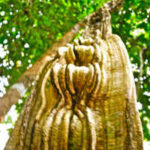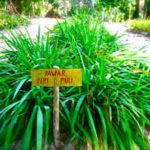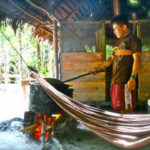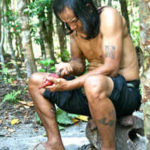Ayahuasca, Shamanism And The Diets Of Healing
I’ll open your thoughts. By doing so I’ll fill you with joy. By doing so I’ll straighten your thoughts. By doing so I’ll straighten your body. now I’ll heal you to the depths of your heart. By doing so I’ll fill you with immense joy. By doing so I’ll return life to your body and to your thoughts. I’ll heal your being, your body, with the powerful essence of the tree and the universe. so you are joyous, remember my words. so you remember them, I will chant them. Though I’m small, I made your thoughts shine. The universe is in harmony.The word is and ever will be.
–– Shamanic Chants of Kestenbetsa (Echo of the Universe) From Jan Kounen’s Documentary About Ayahuasca, Other Worlds.
A unanimous 2006 US Supreme Court ruling freed a US branch of the Brazilian church O Centro Espirita Beneficiente Uniao do Vegetal (UDV) to use ayahuasca as part of its religious rituals. This sacred blend of two Amazonian plants: chacruna leaves cooked with the ayahuasca vine activates the psychoactive dimethyltryptamine (DMT) in the vine producing a hallucinogen banned as a Schedule 1 substance in the USA. An Oregon judge in 2009 issued a permanent injunction barring the federal government from penalizing or prohibiting the Santo Daime branch Church of the Holy Light of the Queen in Ashland, Oregon, from sacramental use of ayahuasca.
This legislative movement occurs as ayahuasca, known as the vine of the dead, weaves its way into major American cities, experiencing increased popularity among communities who are using the master plant medicine in various contexts including celebratory journeys with musical guides, self-navigated consciousness-expanding forays and ceremonies employing the services of highly skilled healing practitioners on tour from the Amazon. With ayahuasca and other entheogens readily available online all you need is a cosmo vision and a credit card.
On any given Friday in Los Angeles a plethora of makeshift malokas (ceremonial rooms) house the mystically-inclined drinking the sacred brew. Studio execs, tinsel town yogis, medical practitioners and hipsters are connecting with sacred plant medicine. Most will probably never see the jungles of the Amazon where the vine is rooted.
Canto para limpieza del cuerpo physico (Shipibo Icaro translation)
I am going to call the visions. The bad visions. The bad songs (of sorcerers). The evil blows. The curses. The bad energies. Reject them, throw them away. Cleaning, cleaning. Blowing, blowing. From the depth of my body. The depth of my blood vessels. The depth of my blood. Finishing, finishing. Cleaning, cleaning. Blowing, blowing. I will clean. Completely your head. Completely your mind and your five senses. Completely your eyes. Your words. Your crown chakra. Cleaning, cleaning. With all the force of my medicine. Entering in your body, cleaning, cleaning. Blowing, blowing. All the bad air.
Welcome to the Jungle. It is a sonic sculpture rendered by unseen insects, birds and animals who announce the day as the morning sun breaks through the clouds.
Ulysses, a twenty-three-year-old indigenous man sits on the side of a rutty sand road, deep in the jungle outside Iquitos, Peru. He considers a butterfly lingering on his fingertip.
Another mile down the road, loosely configured convictions begin to erode like rocks under the influence of weathering and abrasion as the jungle thoroughfare gives way to a path that few will endeavor to walk.
It is a narrow white sand trail that winds its way to other worlds, where master Vegatalista, Guillermo Arévalo (aka Kestenbetsa -Shipibo for Echo of the Universe), has manifested a center called Espiritu De Anaconda. It’s a sprawling forty-plus acre sanctuary of master plant healing where people come to be treated by him and his students and study the sacred science of spiritual herbalism as interpreted in the Vegatalismo tradition. This is the Club Med of Amazonian shamanism.
Large thatched roof structures dominate the expansive, meticulously maintained grounds that include a large dining facility, community room, bungalows, dormitories and deeper into the jungle, tombos – small huts without walls.
The jungle wants to heal you, to wrap you in the warm folds of its massive green matter and cultivate your transformation. But if you dare enter the terrain without a trusted guide, it may consume you alive and use your perishing flesh to fuel its next generation of growth.
Daniel Sipes has been here before. He knows the terrain, the underlying science and the necessity of a skilled guide. A Chinese herbalist from the US West Coast, he sits quietly on the front porch of a large house at the center of the compound drawing deeply on a mapacho (black jungle tobacco cigarette). He is decidedly articulate on the subject of shamanism. “Vegatalismo is the science of spiritual herbalism practiced in the Amazonian shamanic tradition. It’s a complex highly evolved, elegant system of spiritual herbalism that allows the biochemistry and the energy behind the plants to get in and untie the knots inside the complexity of any modern illness.”
“In Vegatalismo, ayahuasca is used to gain insight into the deeper pathologies in your system,” Sipes says. “It’s a tool to diagnose the physical, psycho-spiritual and psycho-emotional disorders that we carry…and even the lineage histories…misaims as they call them…When the Vegatalista diagnoses, he or she gives you a master plant to work with to help work to help clear it all out; you do a dieta. A dieta is a series of disciplines during which you restrain from anything in the extraneous world that may undermine the effects of those plant masters helping with healing: sexual activity and certain dietary activities that interfere with the infusion of the sentience of that plant spirit into your system.”
The protocol goes like this. The shaman, or Vegatalista, diagnoses and gives you a specific master plant, or plants, to address your affliction. The plant(s) prescribed as part of a dieta are usually consumed when in isolation in the jungle. You drink the plant medicine during the day and sit in ayahuasca ceremonies at night where the shaman sings icaros (medicine songs) to you as part of your treatment.
Ceremonies open and close a dieta. When you open a dieta you are energetically connecting to the shaman and the plant. When the dieta is over the spirit of your plant has been eternally woven into the fabric of your energy. It is your teacher, friend and ally. Part of the process is to learn the language of the plant to understand how the plant is communicating with you. It’s not the kind of treatment you would want to undergo with anyone whose skills and abilities are anything short of masterful.
There is also the option of a social diet, a modification of the traditional discipline to accommodate a person who is maintaining their lifestyle with limited isolation. It’s a contemporary variation on the modality that has enabled people to engage with plants who would be otherwise unable to spend time in the jungle.
Sipes draws parallels between Amazonian shamanism and other interconnected indigenous systems, such as Chinese herbology or Ayurveda. “Many herbalists working within complex systems that understand differential patterning are masters of differential diagnosis. For example, many patterns can manifest to create this sensation in your head that you call a headache. Instead of giving you a headache herb, healers using this type of approach take advantage of the synergistic effects of blended herbs. If you have ten people with the same illness, you may write ten different formulas because you’re taking into account all the different variables the person brings into that illness or manifestation.
Analogous to this, instead of saying, “here’s the icaro that brings light into your body,” the Shipibo use an entire intricate vocabulary and grammar in their songs. Each song is different every time because you’re addressing something entirely different every time. When you sit in front of a Shipibo healer the icaros are specific and current to that moment. The language of the icaro changes so the singer can get deeper and deeper and weave the appropriate pattern.”
“The Vegatalistas, especially in the Shipibo tradition, have done extensive dietas, infusing that plant energy into the knowledge base within themselves,” Sipes says. “Subsequently, they can recognize the patterning in peoples’ bodies indicative of different disorders. They access the arsenal of sentient plant spirits accumulated in their power source, utilizing these plant allies and the icaros to reconfigure these imbalanced patterns recalibrating the person and restoring balance.” In the ceremony, ayahuasca is the catalyst. Purging is common: through the bowels, the urinary tract, by vomiting, through emotions and other ways.
Sitting in ceremony in the Amazon with an indigenous healer ingesting master plants also indigenous to the place is a very different experience from working with the plants outside of the jungle where there is no social context for the experience.
Ricardo Amaringo, aka Ronin Sanin, a Shipibo Vegatalista, speaks from the heart while sitting on a log near his house at the far reaches of the compound. Miguel, a Chilean shamanic practitioner and student of Vegatalismo with a lose grasp on English, translates. “I’m working here to help the people,” Ricardo says. “Vegatalismo is the medicine to open the knowledge for the peace. Open the mind. Open the love.”
The reasoning behind the isolation and restriction of a dieta is simple: remove any elements that would circumvent your communication with the plant. “You need to stay in your place in isolation to make the connection with the plant because the plant teaches you…. and opens your vision and with that knowledge… you see the sickness that the person has,” he says.
The icaros are the tool that he uses to treat people in, and sometimes out, of ceremony. Each plant has an individual energy; each plant has its own song.
“The master plants are singing because the ayahuasca is present. Different plants have different kinds of energy and a different kind of song. We’re learning the icaros from the plants. When you’re singing, you call the energy and you put the energy inside of the person… with that energy you heal.”
On arriving at Espertu de Anaconda everyone sits on a big log in front of the medicine hut and is handed a bowl of azuscena by Ricardo. It’s a purgative that causes almost immediate vomiting. An initial cleansing. It’s the first part of the healing.
There are of course many, many plants in his arsenal, including ajosacha, boahuasca, pinon colorado, matico, copaiba oil, sangre de grado, oje, coca, toa, chia, chiric sanango. “Ajo sacha is a master plant, cleaning your body,” he says, “Cleaning the toxins and your arteries…more easy the blood to flowing. Oje is working in the mind, healing psychological trauma.” But ayahuasca is always prominent in the conversation. “The ayahuasca is now a popular plant. A lot of people want to have the beautiful visions. But ayahuasca is only one plant. There are a lot of plants to heal you.”
Ricardo is enthusiastic about potential students finding the path to Peru. “Some people are only coming to take the experience. That’s good that people are coming to take the experience. I I If it’s possible, it’s good to want to be a shaman to help the people, but it is a long way, a lot of discipline… a lot of dietas. Only one plant makes a strong dieta in isolation in the jungle.”
Ricardo disappears down the path with his young wife as Miguel heads for the nearby botanical garden. He pauses in front a tangle of Banisteriopsis caapi (ayahuasca) vine.
Vine of the Dead
“Ayahuasca come to killing you,” Miguel says. “Killing your ego. We build our personality. And we happy with that personality, but it’s an illusion. So when we see the illusion, it kills that construction. Ayahausca coming to you to die you.”
Miguel understands Vegatalismo as a healing art that connects him to nature; plants, animals and their spirits that has opened his vision about disease and healing.
“When you’re healing you have more clarity. People have a connection with their own sickness. Sometimes they don’t want to let it go. It’s part of your life. You don’t know what to do once you don’t have sickness. So you coming here, first to understand what happened to you… after that the healing is coming. But you need to open your mind to see yourself… the truth. It’s like you blind all your life, so you live for the people who put money in your hand. When you no more blind… no more money in your hand. You need to change your life. Here you’re coming to that.”
Miguel started his ayahuasca path twelve years ago, when he was in his forties. He initially thought it was the next substance in his psychoactive journey.
Considerably younger, James is a twenty-one-year-old Austrian who has been in the jungle for months. Laughing, smiling, chain-smoking and constantly plugged into his iPod, the jungle is James’ playground. Fresh-faced, vibrant and saturated with master plants, it’s hard to imagine him as anything other than healthy.
“I came here because I had a skin problem called neurodermatitis. I had it my whole life.” James’s mother in Austria was the conduit to meet Guillermo. “In three-and-a-half months, Guillermo fixed me up completely. I I was really weak when I I arrived, detoxifying from my excessive lifestyle of drugs. For two years before I came here, I had no skin problems. Two days after I I arrived, my skin broke out completely; even some sort of liquid would come out. Crust would build and it would go black. This stage stayed for three months,” he recalled.
During the course of his physical healing, the plants provided James an insight to his condition’s origin, ascertaining it came from something he calls a spirit of trauma when he was a baby. “The skin problem for me was a sort of protection from other people,” he said.
Guillermo gave his a diagnosis and a dieta as soon as James showed up. “They gave me all kinds of plant medicine, flower baths… and the cleaning… the singing in the ceremonies. In the beginning I didn’t drink ayahuasca. I just drank other plants… one week ajo sacha. One-and-a-half months oahuasca, one month pinon colorado and matico. Then I I had to drink copaiba oil and sangre de grado… what I would not recommend to anybody to drink,” he laughs.
Metsa arrived from Europe several decades unknowingly seeking a cure for addiction.After years of study involving extended periods of isolation and many dietas, he is a Vegatalismo master. Trans-continental and multi-lingual, he speaks to a W Western sensibility with a decidedly expansive multicultural awareness.
“The Western mind is curious about spiritually and there is a desire and need for those connections. Modern society has been cutting us off from that. People are looking for techniques, products… whatever. Ayahuasca is an amazing tool to get access to too that journey, to that connection. Today it’s offered in many different contexts; you have the Brazilian Church that offers a space to experience a certain way of using ayahuasca. You have people using ayahuasca in a more musical context… putting people in a certain space guided by music… and you have traditional Vegetalistas who are trained from Peruvian shaman, or Amazonian shamans and following very strict disciplines and diets and offer more healing approach with traditional songs”
Today people in the US mostly focus on the use of ayahuasca as a tool to journey to other worlds of consciousness. The American attraction to shamanism parallels our expanding attitudes about alternative healing modalities.
“From my perspective… which is very personal, other techniques are a more modern integration of different streams and spiritual practices mixed,” Metsa offers. “You need to find integrity in the person leading the ceremony. Are they going to be able to lead you in that journey with safety and take care of your emotions and physical body? Ayahuasca is a strong substance and it demands physiological preparation and certain diet restrictions to integrate the plant and have the most beneficial impact. It could be dangerous if it’s not done properly. It’s important to have respect for the substances and get information and get informed about who is leading the ceremony. Where are they coming from? What is the substance about? What are you looking for? I It is not a recreational drug that you can do and trip out. There is a history and stories around shamanism in Peru… around sorcerers witchcraft and brujo… but I prefer not to talk about it.”
On my way back to the world I left behind in Los Angeles I ran into Miguel on the loose sand road that leads to Iquitos. He told me about a vision he had in an ayahuasca ceremony.
His words resonated as I drift off to sleep on my flight to Lima, the vine winding its way through my consciousness on the vibration of his voice, reminding me of what I I already know: There many roads leading to the same end: the beginning of the journey…the one that starts when we finally understand that it’s us who are responsibility for our own healing. Vegatalismo is a decidedly profound cosmic healing path. Like all paths that lead to all journeys, there are things to surrender for things to gain.
“One day I have a vision,” Miguel says, “I’m singing for the people in the ceremony; it’s a complicated moment, so I call the spirit of the condor; condor manta, from South America. When I called the spirit, in my left side started to grow a massive mountain. And the mountain is an incredible God. On the other side grow a little mountain. It’s the evil inside. It’s all darkness and the evil is laughing. And at that moment I make the question, ‘Hey God, if you so big and powerful why you don’t take away the darkness forever? You have the power for that.’ And the God say, ‘Because I can’t see the darkness.’ I say, ‘What is this, man? I see it… look I can see it. The darkness is here.’ “
“He say, ‘When I created you I created beautiful people in the light. I don’t create the darkness. I create only light, only love. You create the darkness. I I don’t see that. I It don’t exist for me. So it’s your problem. You give life and power for the darkness. Now the darkness is strong guy on top of your head. It’s your job to disappear the darkness. You create the world, pain, torture, sickness, it’s your problem.’ In that moment I see we have a strong mind, we create everything… everything bad too. After that, everything disappeared; I I’m standing alone in the cosmos with another knowledge. We created everything. We created God too. The more purity state of the spirit… there’s no God, no darkness, no nothing… only you in the love.”
The Rain is pouring down, like all the souls you send here. Coming to this Earth to find healing. The earth takes in the rain, like your heart takes my voice. Let us free each other with our prayers… with our voice. And I’m coming home…
-from Ong Namo, by Snatam Kaur, from the album Live in Concert (Spirit Voyage)
See the video Welcome to the Jungle at layogamagazine.com; a foray into ayahuasca through the lens of Peruvian shamanism by filmmakers Sam Slovick and Ryan Wylie.innermissionproducts.com
Sam Slovick is a journalist and documentary filmmaker living in Los Angeles. He is a regular contributor to LA YOGA Magazine, the LA Weekly and others: samslovick.com.espiritudeanaconda.org
By Sam Slovick
Award-winning journalist, documentary director and long-term LA Yoga contributor Sam Slovick is the director, writer and producer of the Radicalized documentary, currently working on the Kirtan Road Dogs documentary.





